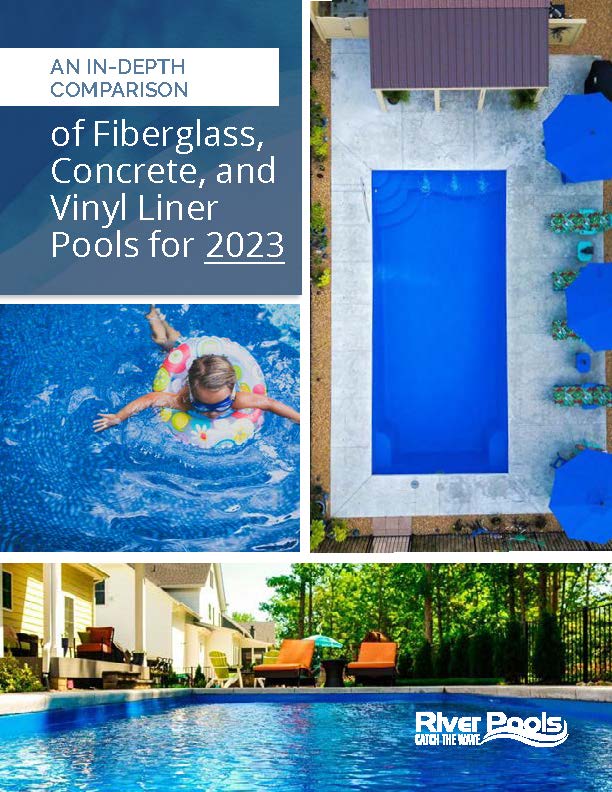River Pools & Spas Blog
The most educational swimming pool blog in the country, providing fiberglass pool articles and videos, as well as information on inground concrete and liner pools.
Fiberglass Pool Information | Installation & Construction | Swimming Pool Accessories
Are you considering an inground pool or, more specifically, a fiberglass pool with an integrated tanning ledge? Are you a fiberglass pool installer looking for best practices regarding tanning ledge pool installations? If so, you're in luck! Today we're going to share our system for installing tanning ledge pools—and reveal our unique manufacturing process to ensure your tanning ledge pool is super awesome. Let's dive right in!
Share
Concrete Pool Information | Installation & Construction | Options and Accessories
Concrete pools are often called “gunite” pools... but you may have heard of "shotcrete" pools, too. Researching your options when you want to buy an inground pool can feel overwhelming if you're unfamiliar with all the terms, technologies, methods, and processes professional pool builders toss around on a daily basis. But it's not as complicated as it can seem from the outside. This guide will help you understand the difference between gunite and shotcrete -- particularly when you want to use this material to build a sleek inground pool in your backyard. When you can speak a pool builder's language, you'll be on firm footing to negotiate your pool project's dimensions, costs, timelines, and options. Let's get started... Concrete fundamentals Concrete is a mix of water, cement, sand, and a coarse aggregate, which is a material made up of small particles, usually small crushed stones or gravel. The difference between sand and aggregate mainly comes down to the size of the particles and (sometimes) what they're made of. The sand you'll find at the beach or in the desert is usually made of quartz or limestone, but sand particles are always smaller than gravel, even if sand and gravel are made up of the same basic chemicals. Dry concrete is considered an "initial mixture" of cement, sand, and aggregate. The process of mixing water into an initial mixture of concrete gives the end product its name.
Share

Don't blindly wonder if a fiberglass, concrete, or vinyl liner pool is right for you. Our educational ebook does a deep-dive comparison of the 3 types, all while noting the advantages and disadvantages of each.
Cost and Pricing | Installation & Construction | Vinyl Liner Pool Information
Most of us have been around vinyl liner pools at one time or another. (For example, my grandparents have one. I now know that they needed to replace the liner years ago. Don't blame the grandkids for rusted wall panels, Nana.) But personal experience doesn't necessarily mean someone knows the details. Curious about the basics? Here at River Pools, we worked exclusively with them for years before we discovered and fell madly in love with fiberglass pools. We’re all about making information available to you and easy to understand. That includes all types of pools.
Share
Concrete Pool Information | Installation & Construction | Swimming Pool Design
What’s the best concrete thickness for your pool? If you’re asking this question, you’re probably already looking at and comparing the pool contractors in your area. The vast majority of us can’t DIY a concrete pool; the process is too complicated and technical. You’ll contract professionals to engineer and construct it. Be sure to ask them the relevant questions we lay out in our Swimming Pool Builder Vetting Checklist to confirm their integrity and expertise.
Share
Installation & Construction | Options and Accessories | Vinyl Liner Pool Information
As tempting as it may be sometimes, you’re not allowed to leave people stranded in your pool. There are laws against that. Swimmers need a way to get out of the water, so you need a ladder at least, if not actual steps, and you have to include them in your design from the beginning.
Share
Installation & Construction | Vinyl Liner Pool Information
Planning a new vinyl liner pool and unsure what to do with the floor? Although River Pools now specializes in fiberglass pools, we started out working only with vinyl liner pools, and we want to share our knowledge so you can make the best decision for you and your family.
Share
Concrete Pool Information | Fiberglass vs Concrete vs Vinyl Liner | Installation & Construction
If you’re planning to buy a concrete pool, have you ever wished you could time-travel to the future and see what the construction process is like? Time travel is, of course, the best solution to any question, but in this case we can provide answers without it.
Share
Fiberglass Pool Information | Installation & Construction | Pool Manufacturing Process
A lot goes into the manufacturing and installation process for a fiberglass pool. It’s especially hard to make sense of all those steps when the explanation includes a lot of pool and science jargon, regardless of whether you’d like a refresher on the basics of a fiberglass pool or already know the components.
Share
Concrete Pool Information | Installation & Construction | Options and Accessories | Swimming Pool Design
When it comes to concrete or gunite pools, the finishing options have expanded significantly in recent years. While traditional plaster remains a classic choice, alternative finishes can offer additional benefits such as increased durability, smoother textures, and unique aesthetic appeal. Exploring these options allows pool owners to customize their swimming experience and potentially enhance comfort for all users.
Share
Installation & Construction | Pool Maintenance | Swimming Pool FAQs | Vinyl Liner Pool Information
Liner wrinkles are part of owning a vinyl liner pool. A liner is very thin, and when it’s initially installed, it’s not uncommon to have some wrinkles in the pool. Wrinkles can also develop slowly over time, which is unfortunately true for both pools and people.
Share